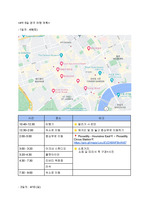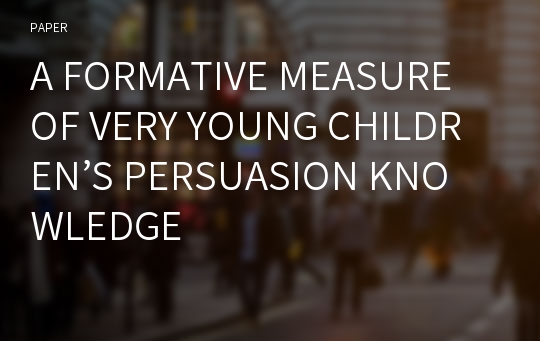A FORMATIVE MEASURE OF VERY YOUNG CHILDREN’S PERSUASION KNOWLEDGE
* 본 문서는 배포용으로 복사 및 편집이 불가합니다.
서지정보
ㆍ발행기관 : 글로벌지식마케팅경영학회(GFMC)
ㆍ수록지정보 : Global Marketing Conference
ㆍ저자명 : Shasha Wang, Dick Mizerski, Fang Liu, Doina Olaru, Victoria Mallinckrodt
ㆍ저자명 : Shasha Wang, Dick Mizerski, Fang Liu, Doina Olaru, Victoria Mallinckrodt
영어 초록
Introduction An individual’s Persuasion Knowledge is his or her knowledge of the persuasive nature of messages (Freisted and Wright 1994). Most adults are assumed to have this knowledge that enables them to be sceptical of persuasive messages, and to incorporate this information in their decision-making about promoted products. Children are viewed as vulnerable to persuasive messages (Nelson 2016) because they have not developed the appropriate knowledge base to be sceptical of messages (Mallinckrodt and Mizerski 2007) and thus unable to discount the claims made by marketers. This lack of ability to be sceptical is argued to lead to “…the vulnerability of young audiences to the negative effects of advertising” (Nelson 2016, p. 169) like obesity, materialism, poor quality of life and higher rates of mortality. Because of the wide acceptance that young children are particularly vulnerable to persuasive messages, advertising targeting children has been banned in several countries and proposed for others (Mizerski et al. 2016; Wang 2016). Many studies about Persuasion Knowledge or Advertising Knowledge (communication research) have been published over the 40 plus years since Ward (1972) first discussed the concept. However, few studies have tested whether Persuasion Knowledge is an antecedent to children’s sceptical responses to persuasive messages. The 11 studies that have tested the link (see Mizerski et al. (2016) for a review) used a wide variety of single item or reflective measures (measures that reflect the construct). They provide inconsistent findings except that the child’s age is positively associated with acquiring knowledge about persuasive messages like advertising or playing advergames. For example, while most researchers assumed or argued a positive link between young children’s persuasion knowledge and their scepticism, Buijzen (2007) and Christenson (1982) failed to find this link. Robertson and Rossiter (1974) reported children’s understanding of persuasive intent (commercials persuade one to buy things) was positively related with young children’s scepticism, but assistive intent (commercials tell one about things) was negatively related. The inconsistent findings of children’s responses to commercial messages may be due to more than the lack of consistent measures. The use of reflective rather than formative measure of young children’s persuasion knowledge may be another reason for inconsistent findings. “Young” children are those under eight years old (Mizerski 1) shashaatperth@gmail.com et al. 2016), but a lack of sufficient persuasion knowledge has been found with children over 16 years old (Carter et al. 2011). Most recent studies have adopted the Freisted and Wright (1994) Persuasion Knowledge Model that is based on the information processing of an adult buyer. Adults tend to have obtained Persuasion Knowledge so their knowledge may be captured with measures that reflect the construct. Young children are in the process of obtaining Persuasion Knowledge. The ability to understand the source of the message and the persuasive intent of the source are often cited as antecedents to having Persuasion Knowledge. These constructs form over time and cause persuasion knowledge (Nelson 2016). Therefore, it should be a formative measure. Measuring social class is a classical formative measure because causal elements like where you live and your profession can’t be accurately calculated for children. Social class forms over time. The use of a reflective measure when a formative measure should be used leads to several problems (Diamantopoulos and Siguaw 2006; Diamantopoulos and Winklhofer 2001), particularly an increase in Type II errors-“false negatives” (MacKenzie, Podsakoff and Jarvis 2005). For example, this means ruling out a causal element of persuasion knowledge when it is causal. This paper will compare existing single item or multi-item reflective measures used with young children, with a formative measure of the Persuasive Knowledge construct. The best way to validate a construct is to test it with external variables empirically and theoretically linked to the construct, including both antecedents and consequences (Diamantopoulos and Winklhofer 2001). Three variables, theoretically and/or empirically linked with young children’s Persuasion Knowledge, are tested in a baseline model to assess the external validity of the construct. These variables are age (Ward 1972), responses toward persuasive marketing messages (such as scepticism) and affect toward the persuasive messages (Mizerski et al. 2016; Wang 2016). Therefore, it is expected that the goodness-of-fit measures for the model using the formative measure of young children’s Persuasion Knowledge will provide a better fit to the data than the reflective measures. To further test the formative nature of young children’s Persuasion Knowledge, two additional models are tested. Researchers are responsible to set the weights of indicators of a formative construct, so a formative model with expert knowledge weights is developed (Figure 1). The indicators or elements of a formative construct should be able to reveal different facets so another model with different facets is developed. Consistent findings of the two models and the proposed baseline model will further support the formative nature of this construct. Apart from content validity and external validity, we also test the measures of the construct with another data set (Mallinckrodt and Mizerski 2007) to test the models’ generalisability. The Mallinckrodt and Mizerski study used children from a different cultural background (Australian vs. Chinese young children), but have similar ages and measures of Persuasion Knowledge and external variables. Further confirmation of the structure of the measurement model is provided if the same relationships are found with the second data set. Methodology Sample The population to be sampled are young Chinese children. China was selected because it has the largest population of young children, is the largest market for toys and a children’s toy is the stimulus product in the experimental study. The sample frame is day care schools in a Northern Chinese city of approximately eight million people. Procedure This is an experiment-based study with a control group. After individual exposure to a toy TV advertisement for a “magic ruler” that can be made into many different shapes with a Dinosaur shape shown in the ad, participants were each asked to answer questions. Cartoon pictures of the question options accompanied by verbal statements were used to reduce the possibility of misunderstanding young children’s responses on Persuasion Knowledge related questions. To reduce any effects of young children choosing the first option they see, pictures or options were shown in a random order. Children were told that there is no right or wrong answer, and they could withdraw at any point. Measures Persuasion knowledge was measured three ways; including a single-item measure, a summated-items measure, and a formative measure. Through an analysis and coding of 20 studies that tested the effect of young children’s persuasion knowledge (Mizerski et al. 2016), six items were found to measure the Persuasion Knowledge construct. The single-item measure used is the children’s understanding of the advertisers’ intention to make them ask their parents to buy (parent-buying intent). This was treated as the most important aspect of persuasion knowledge by several researchers (Carter et al. 2011; Mallinckrodt and Mizerski 2007). A summated-items measure included six items, frequently used in prior scholarly work. The formative measurement model was built using the same six items but by changing the direction of influence, with the causal flow from measures to the construct. Other variables include the children’s scepticism, their belief of false claims made in the ad and affect toward the toy TV advertisement (see Figure). After a CFA analysis with five questions, the scepticism factor score was derived as a standardised measure that followed a normal distribution. Scepticism ranged from -0.59 to 1.35, with an average of 0.07 and SD of 0.68. Belief of false claims (named as “false beliefs”) shown in the TV advertisement indicated that most children did not believe the two false claims included in the ad (84% and 69% respectively). Affect towards the toy TV ad was measured using one question: “Do you like this video?” to which most children (88%) indicated yes. Results, Discussion And Implication Fifty-four different patterns or combinations of the six persuasion knowledge items were found. This pattern show substantial heterogeneity in children’s Persuasion Knowledge, and further illustrates that young children are accumulating or forming their Persuasion Knowledge (Friestad and Wright 1994). In addition, these items have low correlations to one another that are typical of a formative measure. These findings of variability of knowledge levels and weak association between them indicate the potential multiple-dimension, formative nature of the construct of persuasion knowledge for young children. This may apply specifically to young children who are at the stage of increasing their learning abilities and developing or forming their knowledge. No relationship was found in the structural models using the reflective single-item measure and summated-items measure of persuasion knowledge, and the models showed a poor fit. However, relationships were found in the structural model that applied the formative measure of persuasion knowledge, with good model fit (see Table 1). Because a formative measure is supported, we tested the formative nature of Persuasion Knowledge on a previous study’s data (Mallinckrodt and Mizerski 2007). A formative model using that study’s data showed the same relationships between Persuasion Knowledge and its external variables. This consistency supports a formative measure of young children’s persuasion knowledge. Any review of future or past research should note the possible impact of using reflective measures of young children’s Persuasive Knowledge. To generalise the findings more research needs to be done for different product categories and age groups. More product categories, such as food and movies, and age groups could be taken into consideration. While few studies have tested the association of young children’s Persuasion Knowledge to scepticism toward the message, even fewer have tested the link of scepticism to young children’s responses to the advertised product (e.g. like, prefer, choose). Most of these studies do not find a link. If having Persuasion Knowledge doesn’t influence a young child’s desire for the brand, why teach it (e.g. Nelson 2016) or ban advertising because the children don’t have Persuasion Knowledge? Perhaps using a formative measure the link will be found.참고 자료
없음"Global Marketing Conference"의 다른 논문
 THE ROLES OF GREEN PACKAGING IN UGLY FOOD PURCHASE INTE..22페이지
THE ROLES OF GREEN PACKAGING IN UGLY FOOD PURCHASE INTE..22페이지 THE IMPACT OF INDUCED AWE ON ETHICAL TOURIST BEHAVIORS5페이지
THE IMPACT OF INDUCED AWE ON ETHICAL TOURIST BEHAVIORS5페이지 A BIBLIOMETRIC ANALYSIS OF SPIRITUAL TOURISM RESEARCH15페이지
A BIBLIOMETRIC ANALYSIS OF SPIRITUAL TOURISM RESEARCH15페이지 SOCIAL NETWORK ANALYSIS AND RESPONSE TIME TESTING: CONS..11페이지
SOCIAL NETWORK ANALYSIS AND RESPONSE TIME TESTING: CONS..11페이지 THE EFFECTS OF PARA-SOCIAL INTERACTION ON ONLINE CELEBR..3페이지
THE EFFECTS OF PARA-SOCIAL INTERACTION ON ONLINE CELEBR..3페이지 THE INFLUENCE OF OPINION LEADERS ON DAILY DEALS USER’S ..3페이지
THE INFLUENCE OF OPINION LEADERS ON DAILY DEALS USER’S ..3페이지 HOW IMMERSIVE RETAILING AFFECTS CONSUMERS’ URGE TO BUY:..6페이지
HOW IMMERSIVE RETAILING AFFECTS CONSUMERS’ URGE TO BUY:..6페이지 KEY TO SUPERSTARDOM IN A GLOBALISED MARKET: THE ROLE OF..6페이지
KEY TO SUPERSTARDOM IN A GLOBALISED MARKET: THE ROLE OF..6페이지 A POST-PANDEMIC LOOK AT TOURISTS’ PERCEIVED COOLNESS OF..4페이지
A POST-PANDEMIC LOOK AT TOURISTS’ PERCEIVED COOLNESS OF..4페이지 EXTRACTING OFFLINE RETAIL SHOPPING PATTERNS: OLLABORATI..5페이지
EXTRACTING OFFLINE RETAIL SHOPPING PATTERNS: OLLABORATI..5페이지

























